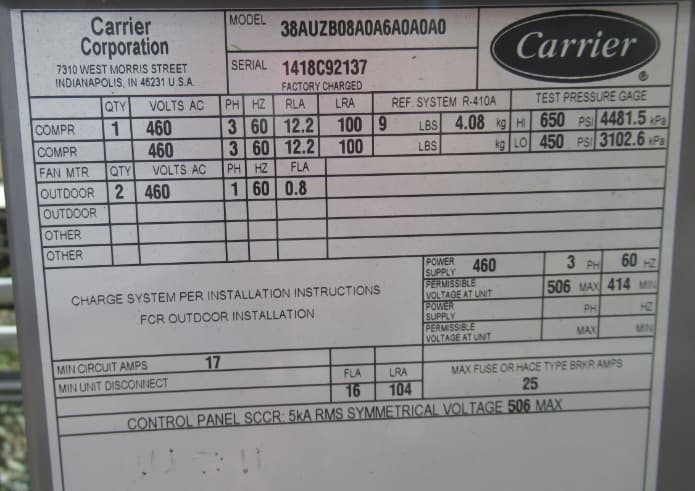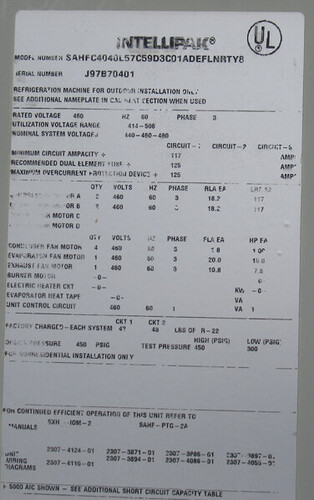Is that “the reason”? I keep hearing different stories. What exactly are they designing? are they not just matching materials against the specs provided by the manufacturer?
Good question. Part of the reason is that residential style AC units are designed for a wide range of voltages. If you look at the photo I posted in a previous post you’ll see that unit will operate from 197-253 volts. The larger MaxOCPD rating will allow this to work. If you look at large commercial AC units they rarely have a MaxOCPD sized much above the MCA because they’re designed to operate in a small voltage range.
Yes, they are doing that, but there are many things taken into account when designing electrical systems and individual circuits. The equipment manufacturer does not, for example decide whether to use a single OCPD or more than one (as in my example in my earlier message). The manufacturer doesn’t determine locations of components in the circuit, the conductor sizes, conduit or cable types, fastener types, enclosures, and so on. In residential wiring, design is usually done by the contractor. In large commercial projects, it is usually done by engineers.
I have held electrical contractor licenses in multiple jurisdictions that required testing. Every electrical contractor test I have taken has included designing electrical systems. At least two of them required a complete material take-off. If you sit down and design a circuit, you will soon see how many design decisions are made, even in the simplest circuits.
Something is missing. Are you saying higher rated OCPD is needed when voltage is low, the one that meets MCA won’t suffice? The two statements above seem to be contradictory.
Interesting. Here is a 7.5 ton unit on a 277/480 volt 3 phase 4 wire for illustration. I see your point Robert, not much variance between min and max for a fairly large unit.
And here is a 40 ton unit, not much variance here either
Speaking of the photo I posted. In order for the unit to operate in the large voltage listed range of 56 volts (197-253) the OCPD would need to be larger than one that would just satisfy the MCA. Since a single family dwelling typically has a system voltage of 240 volts a branch circuit protected at the MCA would be sufficient to start and run the unit. As mentioned when you get into some large commercial units the MCA and the MaxOCPD are closer in size.
Is this because the phases “smooth” out the voltage? (sorry, my terms may not be industry standard ![]() )
)
So if the unit you posted a nameplate photo of was installed in a 208V system, what would the OCPD need to be?
It could be any size from the MCA to the MaxOCPD. As you know the OCPD is there to only provide short circuit and ground fault protection it is not sized to provide overload protection for the equipment or the conductors but it also needs to be large enough so that the unit can start. It can be much larger than the actual running current.
For a single motor a standard inverse time circuit breaker can be sized at up to 250% of the motor FLC. {430.52(C)(1)} The conductors would only need to be sized to 125% of the FLC because the 250% OCPD is not providing conductor overload protection.
How can it be any size when, if installed with lower voltage (say 4 leg 208/120, 3phase), it won’t start the motor (I thought that is what you said indirectly)? What use would the motor be if it cannot be started? We’re going in circles with this. It either needs to be large enough to start the motor and not merely between MCA and maxOCPD, or one that meets MCA will suffice – in other words start the motor even with lower voltage.
So again… something is missing.
I think that it has more to do with the design of the units and the applied voltage when you’re using a 480 volt system. A unit designed for 480 volts will normally see system voltages of 460-480 volts, that’s a difference of about 4% from high to low. For the residential unit in the nameplate I posted the variation of 53 volts would be a 20%+ difference therefore the OCPD needs to be sized to compensate for that range. The best thing about all of this is that if you just follow the MCA and the MaxOCPD you’ll never have a problem with the branch circuit.
The manufacturer decides what the MaxOCPD size is and puts that on the nameplate, but that is the maximum size permitted it doesn’t say on the unit or in the NEC that is the size that’s required. It also says what the minimum size branch circuit is. The NEC defines a branch circuit as: "Branch Circuit. The circuit conductors between the final overcurrent device protecting the circuit and the outlet(s)" A unit with an MCA of 20 amps and a MaxOCPD of 35 amps would be code complaint with a 20 amp conductor and a 20 amp OCPD because that would be a 20 amp branch circuit.
And to your point I’ve heard from many electricians that they use the maximum size listed on the nameplate because of potential nuisance tripping using something smaller. Maybe there is some validity to that when the applied voltage is near the bottom of the unit’s operating range. I don’t know because I have never seen it happen. I agree with you that this is circular logic and it would be clearer if they just said Required OCPD is X.
The motors have built in protection. It is not provided by the overcurrent devices. The overcurrent appears to be larger than needed to account for the inrush current.
Yes that was the point I was trying to convey regarding the OCPD size.
Not All units have the same kw rating. What is the difference in kw rating for a 2.5 ton and a 3 ton. Probably very little if any. How about 2.5 ton and a 4 ton and so on. The calculation is based on the energy, kwatts or btu required to run the specific appliance. Also, the Seer Rating plays its role when calculating power consumption.
I pray that the AGE of the appliance does NOT play a role in anyone’s calculation of electrical circuits and components.
No.
1.76kW
Nothing is missing. Don’t make this into something more complicated than it is. Follow the nameplate. That’s it. End of story.

